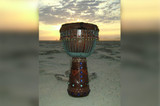How a Djembe is Made: Shell Carving & Hand Painting
How a Djembe is Made: Shell Carving & Painting by X8 Drums from X8 Drums on Vimeo.
Producing hand-carved, hand-decorated djembe drums is not only a tradition, it's an art form that is over a thousand years old!
Yet maybe you have wondered precisely how a djembe drum is made? How it goes from a individual piece of plantation grown mahogany hardwood to the beautiful hand drum shown here?
The job can demand the collective skills of 4 to 6 different artisans, each one providing their very own unique talents and skills at the crafting process.
And because excellence can't be in haste, finishing just one djembe drum may take somewhere from several hours to a few weeks to complete.
To gain a better understanding of exactly how a djembe is made, take a look at the building of our popular Endeavor Series Celtic Labyrinth drum.
As soon as the logwood is shaped and sanded smooth, the carver lightly traces the basic Celtic Labyrinth design with a pencil so he is able to follow the bands while he carves. Employing a bent-tipped chisel along with mallet, he begins to patiently nick away at the wood and define out the distinctive design.
Notice how the carver uses his feet like a brace to stop the drum base from rolling as he chisels.
The Celtic Labyrinth pattern he's working on is among the more easy carvings for an artisan and will take him about 30 minutes to finish. Yet, more intricate and refined carvings can take several weeks to complete depending on the pattern and complexity.
A lot of drum carvings involve recognizable African designs, ceremonial tribal art, even imagery that tell stories and fables handed down from the ages. And, since each design is carved by hand, no two are ever quite the same.
Modern machinery could possibly do the carvings faster, but it’s the hand crafting, pride and skilled focus on the details that offer the djembe its one-of-a-kind uniqueness and distinct sound.
After carving out the rings around the base, the artisan begins to chisel through the intriguing Celtic Labyrinth design. For wider cuts, he firmly holds the bent chisel, gradually decreasing on the pressure while he moves along to create slimmer and more pointed ends.
He carver then changes to a flat chisel to complete cutting out the wider bands at the base.
Demonstrating a delicate touch and skilled hand, he delicately finesses the design, at times using the mallet, sometimes nudging the chisel with just his hand, chipping out the last of the labyrinth pattern and working out any flaws in the carving until he gets it to the ideal state.
As soon as design is carved, the drum is passed on to a different artisan for sanding. She first moves an orbital sander across the entire drum body, vigilantly removing out any rough spots and blemishes in the wood.
For additional precise sanding, she makes use of a standard power block sander which gives the drum its eventual level of smoothness. Once the drum is completely sanded and dusted, it is ready to be hand painted.
Various artists are skilled in hand-painting distinct designs, and it is not uncommon for more than one artist to paint the very same drum. Right after each section is complete, unwanted paint is wiped away and evened out with a cloth or sponge.
After the carved labyrinth design is painted, the artist lightly brushes again over it for color contrast, careful not to paint into the carved out areas. To accomplish the ultimate look, this drum gets somewhere between four and six coats of paint. A final coat of clear lacquer delivers the djembe its lustrous finish.
So now you've witness the making of a beautiful hand-carved, hand-painted djembe!
There is certainly a lot of work and time required to create a djembe drum, but for the artists that dedicate their time and talent into each djembe, it becomes less like work. It's closer to a "labor of love".
Watch Part 1 of the "How a Djembe is Made" series: Djembe Wood Source and Lathing
Next: Compare Brands of Djembes
Djembe Buying Guide
2. Djembe Wood Source & Lathing [Video]
3. Djembe Shell Carving & Painting [Video]
5. Which Size Djembe is Right for Me? [Video]
6. Key Tuned vs. Rope Tuned Djembe
7. Djembe Drum: Wood vs. Synthetic
8. How to Tune a Djembe [Video]
10. A Note About African Djembes
11. Djembe Rhythm Exercises [Video]
12. Djembe Rope. Why Quality Matters.
13. Taking Care of your Djembe
15. How to Play the Djembe [Video]
16. Play the Djembe is Easy for All!
Recent Posts
-
What is the Best Size Djembe for Beginners?
If you're new to the world of percussion and interested in learning the djembe, you're in for a t …16th Jul 2024 -
The Benefits of Becoming a Drumming Teacher: Transforming Passion into Profession
Why become a drumming teacher? Becoming a drumming teacher is an excellent way to share your pas …22nd May 2024 -
What Makes the Djembe Drum a Spiritual Instrument in African Music?
Origin and history of the Djembe drum The Djembe drum originates from West Africa and holds sign …16th May 2024



